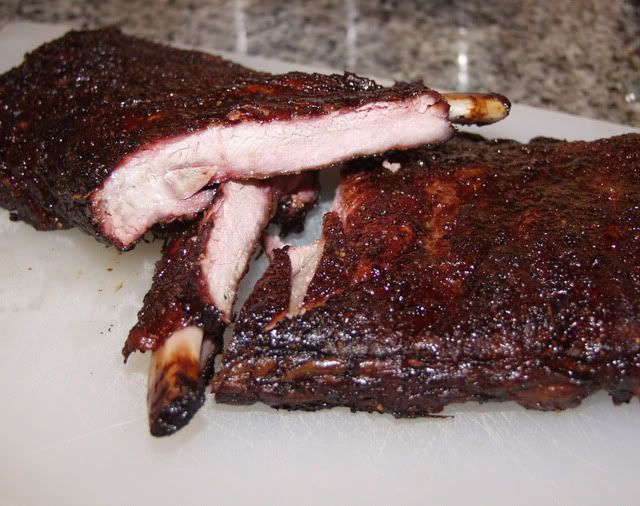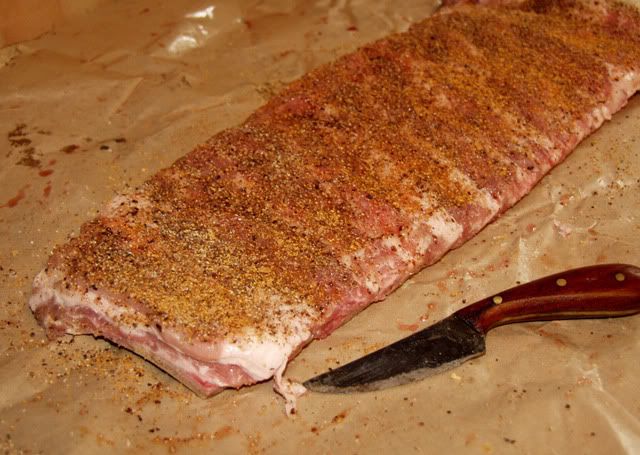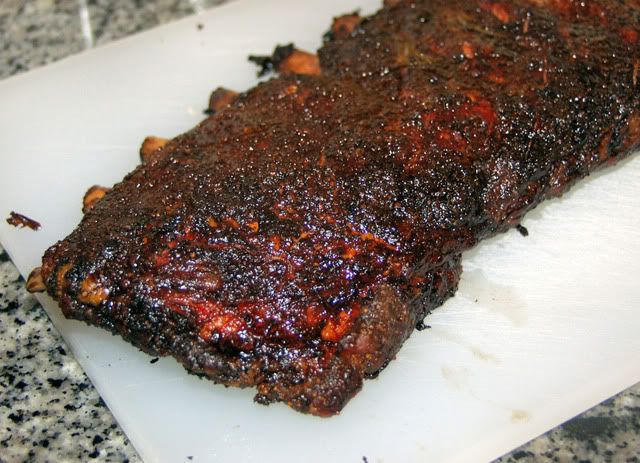On the BBQ forum I frequent, The BBQ Brethren, there is a current thread where one of the members is going through the extraordinary process of testing out all sorts of recipe for sauces. I submitted one that is unique to me that uses a lot of reduction to create sweetness, texture and complexity. This spurred in me a new idea, the idea being that ribs can be so good when you get a good rack that gives off what we call pig honey. It is the mixture of proteins, sugars and rendered tissue that rises to the surface of the meat. A sauce will not achieve this, but, what if I could find a moisture that would enhance the moisture and appearance of this material. Just posting this to keep you looking...
I decided a start would be to develop a mix of sugars, proteins and lquid that would create a sweet/salty/proteiny blend (how you like that word?). This would be thin, but, with enough sugar to create a surface glaze. This would be sprinkled on the meat just as the real 'pig honey' starts to weep from the ribs. Next, the rack was prepped and the kettle fired up. The kettle is loaded with the standard Kingsford briquettes and a few lumps of apple wood.
Yes, that is a large cast iron skillet in the bottom, half full of water to add both moisture, catch drippings and act as a thermal mass on the fire rack. The kettle was stabilized at 235F and had a nice sweet blue apple smoke. The ribs were Beeler's Heluka breed pork, prepared St Louis style and trimmed up free of loose fat. I really like this brand of pork, it is always fresh, the fat is clean and white and the meat is very similar to older heritage breeds in that it tastes porky and is well marbled. Yeah, fat, I get it, just don't eat the whole rack. Here is the raw rack...
The ribs were treated with a no-salt black and white pepper rub (courtesy of a friend just back from Vietnam, Phu Quoc Pepper is the real deal) and then some Simply Marvelous Cherry rub when going onto the grill. The rack was allowed to sit for two hours with a no-salt rub and then 1/2 hour with the Cherry Rub. Here it is, ready for the grill.
And here is the meat on the kettle, along with a fatty with Salt-free Dizzy Dust (this stuff is great sliced and on an egg sandwich) and some pork cheeks with Phat Matt's Signature Rub, also a salt-free rub. This will end up becoming something more once they get smoked up for a couple of hours. Pork cheek carnitas anyone?
I digress, so I took the sauce and out it into a bottle with holes popped into the top which would allow me to sprinkle the pork. The sauce ended up being a thin and very complex liquid that I felt would be best applied during the cooking process. I then let the ribs cook at 235F for 5 hours and got these out of the cooker.
These were quite good, in fact, the sauce worked just as I had hoped. The flavor and texture of the bark was exceptional with the possible issue of a little too much black pepper. These ribs ended up just a little too long on the kettle, the problem with cooking while working, you get on the phone at the worst time. Ended up the ribs were a little too easily pulled from the bones, which, I am sure many would love.
Bob's Black Pepper Rub
3 parts medium grind white pepper
2 part medium grind black pepper
1/4 part powdered mustard
1/4 part chile powder
1/4 part lime powder or citrus peel
1/8 part fresh ground nutmeg
Combine all ingredients and use immediately. This rub relies heavily on the black pepper and loses pungency rapidly. I used black and white pepper from Phu Quoc Island, as this is my new standard for the best black pepper available.
Pig Honey Sauce
1 cup apple juice
1/4 cup Red Boat Fish Sauce
1/4 cup Braggs Amino Acids
1/8 cup Honey
1 Tablespoon turbinado sugar
Combine all ingredients and bring to just short of a boil, maintain heat until sugar is dissolved. See above for use. I believe it is important not to boil this mixture as I believe the boil process will cause the proteins to denature and not function in the manner I want it to work. I have also become aware of the loss of character that fish sauce can suffer when excessively boiled. I am starting to think it needs to be added late in the cooking process, although I have not discussed this with any scientists.






Sounds like a great way to add yet another layer of flavor to the ribs. Did you still sauce them at the end?
ReplyDeleteNope, I was trying to create a rib that was sort of 'self-saucing' and this was close. Certainly no sauce was needed.
ReplyDeleteMan, you rock, Bob. I love how you explain your thinking process going into this. Very creative.
ReplyDeleteThanks Chris, I do think too much about food.
ReplyDelete